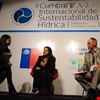


Journalists from print media and broadcasting attended a workshop organised by GWP Cameroon in Douala in December 2012.

The Sixth Session of the Meeting of the Parties to the UNECE Convention on the Protection and Use of Transboundary Watercourses and International Lakes was held in Rome in November 2012.

GWP Southern Africa has for the first time entered into a USAID competitive bidding process led by a US private sector firm.

In 2012, GWP Southern Africa secured 1.3 million from the Southern African Development Community (SADC) through the harmonised donor fund for transboundary water management to implement a project mainstreaming climate change in the SADC water sector.

GWP Central and Eastern Europe and GWP Slovenia are now able to support water management processes and be involved in activities related to public participation and education through GWP's observer status at the International Sava River Basin Commission.

Chile's export-oriented economy based on products like copper, fruit, wood, salmon and wine – all of which need water for their production – has led to a significant increase in water use.

The importance of the IWRM approach in the socioeconomic development of a nation was the focus of a workshop arranged by GWP Central African Republic in Bangui in 2012 that brought together NGOs, the University of Bangui, and the country's GWP Partners.

National IWRM visions, resulting from a ten-year pilot project in the Fergana Valley based on GWP's concept of IWRM, have been approved, adopted and released by the national water authorities.

GWP South Asia, in collaboration with the Asia Pacific Adaptation Network, has published a report on Issues related to Water and Agriculture in South Asia to help improve the exchange of information on water resources management and climate change adaptation among South Asian countries and pave the way for improved cooperation and policy reform.

Stakeholder consultation has led to improved services from the Nepal Water Supply Corporation – Biratnagar (NWSCB) that serves 10,000 households.